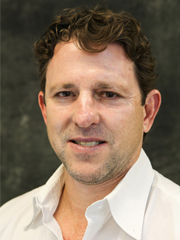Neutrophils-The Warrior Cells
Scott Simon is interested in blood-cell function, but his specific area of interest is the behavior of one type of white blood cell, called the neutrophil. Neutrophils are in concentrations of about a billion per liter and circulate in the vasculature for only a few hours before being cleared in organs. Their goal over this interval is to surveil the circulation and peripheral tissues for bacteria and other foreign invaders and to home to sites of inflammation. To perform this bacteriocidal function, they are endowed with active motile machinery, can detect the “molecular scent,” of invaders through receptor-ligand interaction, and contain enzymes both to kill invaders and to help initiate wound repair. Professor Simon’s research focuses on the mechanics of adhesion and the movement of neutrophils. Neutrophils interact with endothelial cells that line the walls of blood vessels. The flow of blood sets up repellent stresses and the cells roll until they are activated by sensory receptors. Once activated, they adhere to sites of inflammation and also aggregate with each other. In addition to stimulatory receptors, neutrophils express several classes of adhesion receptors that make them very “sticky.” These molecules enable them to adhere to sites of inflammation and at sites of injured tissue, such as the myocardium during a heart attack. These studies have a number of important applications. For example, some kinds of cell aggregation may be very sensitive indicators of inflamation, and understanding the basic mechanisms that control the adhesion and migration of neutrophils may lead to new therapeutics in fighting heart disease and cancer. In Professor Simon’s laboratory, technologies are developed to “sense” molecular scale forces associated with neutrophil adhesion, such as a phase contrast microscopy linked to piezo-controlled force transducers. Direct imaging of the dynamics of cellular adhesion as they interact with vascular endothelial monolayers in parallel plate flow chambers is accomplished by real-time video microscopy, coupled with automated image analysis. Flow cytometry coupled with shear flow chambers provides “electronic imaging” of the molecular events supporting cellular adhesion and functional activation.





